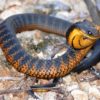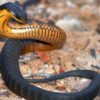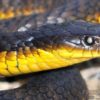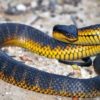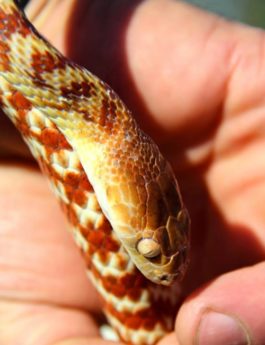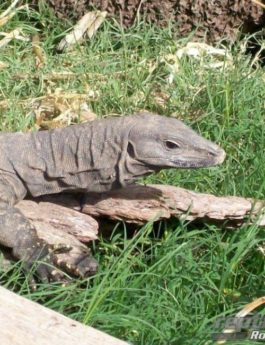Two subspecies recognised. Status of western form is uncertain; regarded here as being a subspecies of N. scutatus. N. s. scutatus (Peters, 1861) Ground colour extremely variable, ranging from pale grey through shades of brown, olive, reddish-brown to black. Pattern usually consists of narrow ragged-edged pale bands; boldest anteriorly. Some individuals lack pattern. Ventral surfaces cream, pale yellow, olive to grey; often darker grey on throat and beneath tail.
Shelters beneath rocks, logs or surface debris, and in abandoned burrows (including those of large crustaceans) beside creeks and other well-watered areas. Carnac Island population usually shelters in shearwater and penguin burrows. Favours margins of swamps, rivers or other bodies of fresh water, in cool to mild climates over much of southern Australia. Isolated populations occur as far north as highlands of the Carnarvon Ranges in central-eastern Qld. Penetrates semiarid areas of north-western Vic. and south-western N.S.W. N. s. occidentalis occurs in south-western WA from Point Malcolm in east to Jurien in north. Abundant on Carnac and Garden Islands, near Fremantle. Both subspecies are common in many suburban areas.
Terrarium: Tiger Snake’s do not require an enclosure with very much height, however if given the correct environment with climbing enrichment they will explore their enclosure. The enclosure needs to be large enough to provide multiple hide rocks and maintain a thermal gradient, a terrarium that is 90x45x45cm (WxDxH) would be suitable to house a mature Tiger Snake. Terrarium’s must be lockable and escape proof.
Lighting & heating: UVB lighting is not essential to Tiger Snakes, however a low 2.0 spectrum fluorescent globe can be used for viewing purposes. Heating can be provided with a heat tile, mat or cord to maintain a ground surface temperature of 32°C in the hot spot. Ambient heat can be provided with an infrared heat globe to maintain a daytime temperature of 36°C in the warm end and 25°C in the cool end, on warmer days you may not need to turn on the heat globe as the ambient temperature of the enclosure may already be high enough. A thermometer should always be used to monitor the temperature within the enclosure.
Furnishings: It is important to provide your Tiger Snake with a hide cave in the warm end, a water bowl at the cool end, and artificial plants will give coverage and decoration. Large Logs and vines can be used within the enclosure to provide climbing enrichment. A pet bedding wood chips such as Chipsi or Critter Crumble can be used as a substrate. It is important to keep the enclosure basic and easy to maintain, as a cluttered terrarium can make it very dangerous when you need to remove your venomous snake from the enclosure for any reason.
Food in captivity: All snakes in captivity must be fed dead food. A Tiger Snake will eat a variety of frozen and thawed mice, rats and chickens of appropriate sizes. On average they will have 1-2 food items every 7-10 days.
The essentials:
- Terrarium of appropriate size
- Tummy heating
- Thermometer
- Infrared Heat globe
- Water bowl
- Substrate
- Hide cave


